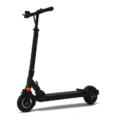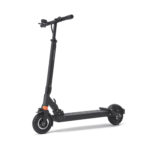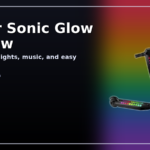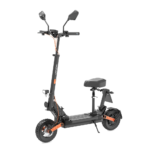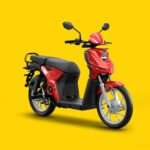- Home
- Scooters
- Electric Scooters
- JOYOR Y10
JOYOR Y10
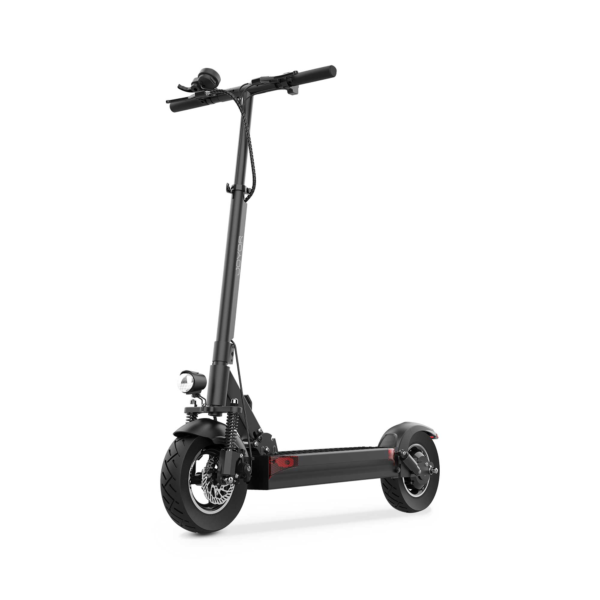

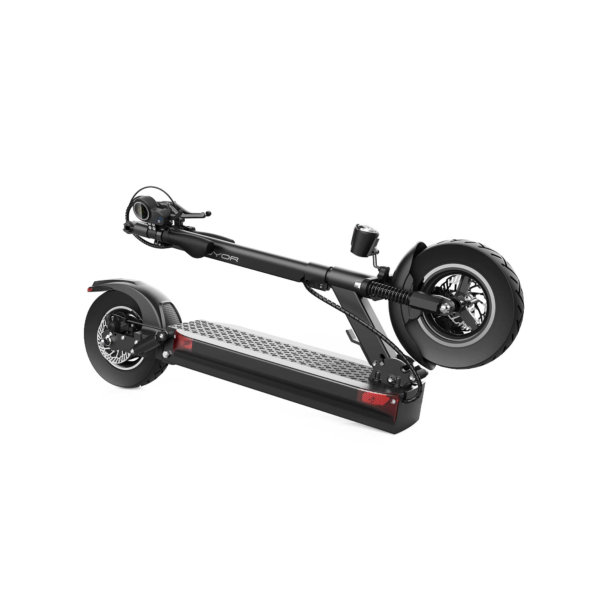
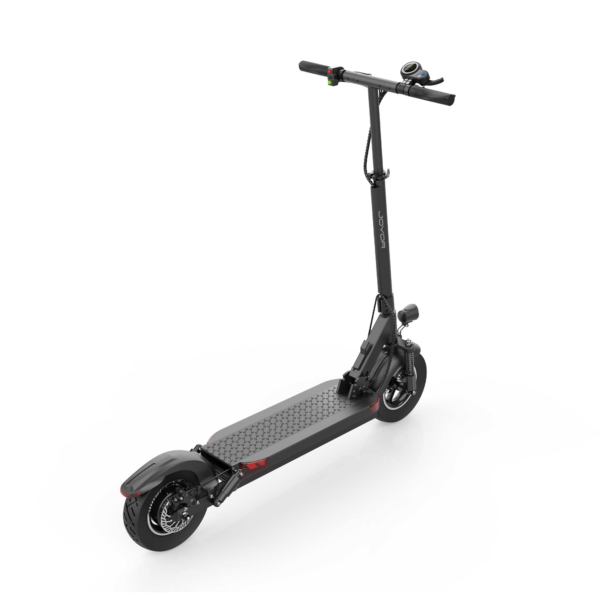
- Battery Range: 59 mi (95 km)
- Top Speed: 18–22 mph (30–35 km/h)
- Motor Power: 500–800 W nominal
- Weight Capacity: 265 lb (120 kg)
- Charging Time: ~8–9 h
- Scooter Weight: 44.0 lb (20.0 kg)
PROS
- Very long range per charge
- Planted long-wheelbase ride
- Predictable electronic + mechanical brakes
- Compliant lighting for low light
- Roomy deck for stable stance
CONS
- Heavier than short-range models
- Larger folded footprint
- Pneumatic tires require care
- Top speed may be region-capped
Table of contents
- What Is the JOYOR Y10?
- How the JOYOR Y10 Works
- Key Specifications
- Design & Build Quality
- Performance Fundamentals
- Battery, Range & Efficiency
- Ride Quality & Comfort
- Braking & Safety Features
- Portability & Daily Usability
- Maintenance & Care
- Weather & Seasonal Considerations
- JOYOR Y10 vs Alternatives
- Who the JOYOR Y10 Is (and Isn’t) For
- FAQs
- Glossary
- Final Thoughts
If you want a long-range city scooter that still feels calm and manageable in daily traffic, the JOYOR Y10 is designed with that sweet spot in mind. Consequently, it favors stability, generous deck space, and an easygoing ride over flashy numbers. Commuters, students, and weekend explorers will appreciate its simple controls, practical suspension, and confidence-building braking. Although it is not a track sprinter or a trail bruiser, it thrives on routine miles, mixed weather, and the stop-and-go rhythm of real streets.
What Is the JOYOR Y10?
Broadly speaking, the JOYOR Y10 is a comfort-focused, long-range electric scooter for urban and suburban travel. In practice, it aims to reduce friction in daily riding: step on, power up, set a pace, and cover meaningful distance without obsessing over every watt or gear tweak. Moreover, the cockpit is straightforward, the folding mechanism is familiar, and the stance is roomy. Because it is tuned for predictable behavior rather than raw aggression, it suits riders who value efficient commutes and routine errands more than sport riding.
Design choices highlight that intent. For example, a large deck encourages a natural, staggered stance. Additionally, a tall stem allows a neutral arm angle for many riders. Meanwhile, suspension and tire choice focus on forgiving comfort rather than razor-sharp feedback. The drivetrain delivers steady acceleration from a stop and holds a relaxed cruise without constant micro-inputs. In short, it is built for consistency: the kind of scooter that becomes invisible under you while the city rolls by.
How the JOYOR Y10 Works
At a high level, an e-scooter is a simple electrical system wrapped in a rolling chassis. The JOYOR Y10 follows that template with components aimed at smooth output and predictable control.
Motor: A brushless hub motor sits in one wheel, eliminating chains and gears. Think of it like a quiet, sealed donut that spins the wheel directly. As a result, power delivery is tuned for gentle initial pull and steady mid-pace pacing, which helps new riders feel in control and keeps tire slip in check on slick pavement.
Controller: The controller is the scooter’s brain. It interprets throttle input, blends in any electronic braking, and limits current to keep the system safe. Importantly, it decides how quickly the motor ramps up and how strongly it holds speed. On the JOYOR Y10, the controller targets smoothness—no jumpy surges from a standstill, and a cruise that feels easy on the hands.
Battery: A lithium-ion pack mounted inside the chassis stores energy. Cells are arranged in series/parallel groups to meet the scooter’s voltage and capacity needs. Furthermore, a built-in battery management system (BMS) balances cells during charging, monitors temperature, and guards against over-current or over-discharge. Capacity is sized for long daily routes without mid-day top-ups for most riders.
Throttle: The thumb throttle sends a simple signal: more press equals more power. Usefully, the Y10’s response curve is mild at the start and firmer after the first part of travel, so parking-lot maneuvers feel precise while neighborhood cruising remains relaxed.
Brakes: Mechanical disc brakes on at least one wheel provide the main stopping force. Typically, lever feel is linear, with predictable bite after a short pull. In addition, an electronic cut-off reduces motor power the moment you squeeze the lever, and some mild regenerative assist may help scrub speed near the end of a stop.
Taken together, these parts create the scooter’s personality. Consequently, the JOYOR Y10 feels consistent: it rises off the line in a measured way, holds pace without drama, and slows with a steady squeeze rather than a sudden grab.
Key Specifications
Below is a clean, rider-oriented look at the scooter’s most relevant details. It’s organized by practical themes rather than a long, mixed list. These specifications may vary by market or production run, so always confirm the exact trim you’re considering.
General
| Item | Details |
|---|---|
| Intended Use | Urban and suburban commuting; daily errands |
| Rider Profile | Beginners to intermediate riders prioritizing range and comfort |
| Wheel Size | Large-diameter urban tires (commuter-class) |
| Tire Type | Pneumatic on most units; check local variant |
| Handlebar Height | Comfort-oriented, neutral arm angle for average riders |
| Water Resistance | Basic splash resistance; avoid deep puddles |
Performance & Power
| Item | Details |
|---|---|
| Motor Type | Brushless hub motor (direct drive) |
| Drive Layout | Single-motor configuration |
| Controller Tuning | Smooth start, steady mid-pace, predictable ramp-down |
| Riding Modes | Multiple modes for limiting speed/response |
| Hill Behavior | Handles common neighborhood grades; short 7–10% ramps require momentum |
Battery, Charging & Electrical
| Item | Details |
|---|---|
| Battery Chemistry | Lithium-ion with BMS for safety and cell balancing |
| Voltage & Capacity | Long-range commuter class (varies by region) |
| Charging | Stock charger optimized for overnight top-ups |
| Charge Port | Sealed against spray; avoid charging in the rain |
| Electronics | Simple cockpit display; essential ride data visible at a glance |
Build & Dimensions
| Item | Details |
|---|---|
| Frame | Sturdy alloy frame with reinforced stem junction |
| Deck | Generous length and width for staggered stance |
| Ground Clearance | Commuter-oriented; watch tall curbs |
| Folding Mechanism | Familiar latch-style fold with safety catch |
| Weight | Mid-weight commuter class |
| Unfolded Size | Typical city-scooter footprint; stable wheelbase |
| Folded Dimensions | Compact enough for a sedan trunk or office corner |
Safety & Control
| Item | Details |
|---|---|
| Brakes | Mechanical disc setup; electronic cut-off support |
| Lighting | Integrated headlight and tail/brake light for visibility |
| Reflectors | Side and rear reflectors on most trims |
| Traction | Urban tires optimized for pavement grip |
| IP Considerations | Splash-friendly, not submersion-ready |
Features & Extras
| Item | Details |
|---|---|
| Display | Clear speed/assist readout with battery indicator |
| Cruise Control | Available on many units; activation varies by region |
| Walk Assist | Low-speed push aid on some trims |
| Anti-Theft | Kickstand and basic power-on logic; use a physical lock for parking |
| App | App-free operation on most variants; simple controls on the bar |
Warranty & Compliance
| Item | Details |
|---|---|
| Warranty | Region-dependent; keep proof of purchase |
| Compliance | Market-specific rules apply; follow local road regulations |
| Support | Routine maintenance parts commonly available through dealers |
Design & Build Quality
The JOYOR Y10 looks and feels like a practical travel tool. The frame is a robust alloy structure with a reinforced hinge area that resists the micro-flex you feel when rolling over rough joints. Moreover, the deck is long and usable, which matters more than you might think; a proper staggered stance reduces fatigue on longer rides. Grip tape runs the full length, and edges are finished cleanly to prevent peeling.
Up front, the stem height supports a neutral elbow bend for many riders. Consequently, steering inputs feel calm. The cockpit layout is tidy. The display is legible in daylight and unobtrusive at night, avoiding glare. Meanwhile, the throttle and brake lever sit exactly where your fingers expect them to be, so you do not need to glance down before every action.
Cable routing is straightforward and serviceable. In other words, you can follow a line from the lever to the caliper without wrestling hidden channels. Fasteners are sized sensibly; they are neither delicate nor oversized to the point of weight bloat. The folding joint engages with a firm click, and the secondary safety keeps accidental releases at bay. When folded, the scooter holds its shape and does not rattle—a small, daily quality advantage.
The finish is pragmatic. Coatings resist road grime, and the surfaces you touch often—grips, throttle, latch—keep their feel after months of real commuting. This is not a show scooter; instead, it’s the kind of thing that looks the same after a rainy week, which in practice is what counts.
Performance Fundamentals
Acceleration feel: From a dead stop, the JOYOR Y10 eases into motion. Thankfully, the first meter is gentle, which helps in busy bike lanes and crowded plazas. After the initial roll, power settles into a steady push that holds speed without hunting. Notably, it does not lurch when you nudge the throttle, and it does not fade abruptly if you back off slightly.
Cruising stability: At neighborhood and city speeds, the chassis tracks straight. Because a modestly long wheelbase and compliant tires calm small bumps and seams, the scooter feels settled. The stem resists twist without feeling harsh, and the deck’s usable area lets you shift your stance to stay loose over uneven pavement. On fresh asphalt, the scooter feels planted. Conversely, on worn brick or patched tarmac, it remains predictable, which is more important day to day.
Hill-climb behavior: Short hills around 7–10% are manageable with a running start. If you begin from a stop on a steep ramp, expect a deliberate climb rather than an urgent sprint. On extended, steep grades, the JOYOR Y10 is steady but not aggressive. After all, it is tuned for distance and comfort, not for attacking every incline like a sport machine.
Battery, Range & Efficiency
Battery performance blends chemistry, controller logic, terrain, and weather. Naturally, the JOYOR Y10 favors endurance over burst power, so real-world range is strong for a commuter chassis—especially when you choose a conservative ride mode and keep speeds steady.
Rated vs real-world: Manufacturer ratings assume steady conditions and a moderate rider weight on flat ground. In reality, rider mass, rolling resistance, temperature, wind, and frequent stops all eat into distance. Consequently, heavy riders in cold weather will see shorter range; lighter riders on warm, flat bike paths will see longer rides.
Rider weight and terrain: Expect more draw during accelerations and climbs. If your route includes hills or frequent stoplights, your effective range drops compared with a long, open stretch at a steady pace. Therefore, use momentum intelligently: crest hills smoothly, and avoid repeated full-throttle bursts.
Temperature: Batteries prefer mild temperatures. Cold thickens lubricants, stiffens rubber, and reduces battery output. Conversely, hot days raise pack temperature and may trigger protective limits. To protect longevity, store and charge the JOYOR Y10 at room temperature when possible.
Charging best practices: Let the scooter cool to ambient before charging after a long ride, and stop charging soon after it reaches full. Additionally, avoid deep discharges when you can. Topping to a comfortable level for your next commute is usually better for longevity than running from 100% to near-empty every day.
Efficiency habits: Smooth throttle inputs, steady cruising, and sensible tire pressure make a noticeable difference. As a result, keep the drive rolling and your range stretches; fight terrain and wind with constant surges and it shrinks.
Ride Quality & Comfort
Comfort defines the JOYOR Y10. The deck is long, the stance is relaxed, and the chassis filters chatter before it reaches your knees and wrists.
Tires: Pneumatic tires on most variants cushion road texture and improve grip in variable conditions. Compared with solid tires, they are more forgiving on expansion joints and brick, and they deliver more feedback as you approach their grip limits. Crucially, keep them at recommended pressure for your weight and weather—soft enough to absorb bumps, firm enough to prevent pinch flats.
Suspension behavior: The suspension is tuned on the compliant side. Over small, frequent bumps, the scooter remains composed and quiet. Over deeper potholes or speed humps, the springs absorb the hit, then settle without a harsh rebound. If you ride with a backpack, you may feel a touch more bob; however, a staggered stance and unlocked knees help.
Ergonomics and stem flex: The stem resists noticeable flex under normal commuting loads. At higher speeds on rough surfaces, you may sense a whisper of movement, but not enough to feel vague. Meanwhile, grips are comfortable and do not twist under pressure. The lever throw is short, with bite arriving halfway through the pull, which makes repeated braking in traffic less tiring.
Braking & Safety Features
Braking is calm and confidence-building. The JOYOR Y10 uses a mechanical disc setup for strong, consistent stopping. Typically, a gentle squeeze slows you predictably; a firm squeeze scrubs speed quickly without drama. In addition, electronic cut-off ensures the motor is not fighting your stop, and some regenerative assist may kick in near the end, helping smooth the final roll-down.
Lights: A bright headlight helps you see and be seen at dusk. Moreover, the tail light brightens under braking to signal deceleration. Side reflectors add visibility in cross traffic. For night riding, consider a helmet-mounted light to project exactly where you look.
Traction: Urban tires deliver dependable grip on dry pavement. In the wet, ride smoother: extend your following distance, brake earlier, and avoid painted lines or metal covers. Thankfully, the scooter communicates grip limits through feel rather than surprise slides.
Ingress protection: The chassis handles splashes but is not meant for prolonged rain or standing water. Therefore, after wet rides, wipe the scooter down and check the brake rotors and pads for grit.
Portability & Daily Usability
Daily life is about pushing, folding, carrying, stowing, and locking without friction. The JOYOR Y10 folds down quickly with a secure latch and safety catch. As a result, the folded package fits under a desk or along a hallway wall. It is mid-weight for its class, so short carries up stairs are feasible; longer climbs are easier with a hand on the stem and another under the deck.
The kickstand is stable, and the scooter parks with little drama even on sloped pavement. Furthermore, the charging port sits high enough to avoid curb splashes and low enough to keep cables tidy on a desk. The display shows what you need and stays readable in both daylight and night glow.
For security, use a reliable lock through the frame and a fixed object when leaving the scooter outside. Because it is a commuter machine, it attracts practical thieves, not collectors; basic caution goes a long way. Indoors, designate a charging nook with airflow and a clear floor around the scooter.
Maintenance & Care
Routine maintenance keeps the JOYOR Y10 feeling new. Fortunately, most tasks are simple and fast once you build a habit.
Tire pressure: Check weekly. Under-inflation invites pinch flats and mushy handling; over-inflation reduces grip and comfort. Therefore, use a gauge you trust and adjust for your weight and weather.
Brake adjustment: Cable-actuated disc brakes need periodic cable tension and caliper alignment checks. If you hear rotor rub after a curb hop, center the caliper and re-tighten. In addition, keep rotors clean; avoid chain lubes and contact cleaners that leave residues.
Fastener checks: Once a month, inspect stem bolts, axle nuts, and the folding latch hardware. Use appropriate torque, and avoid over-tightening. When necessary, a dab of thread treatment on frequently loosened fasteners can help.
Firmware/app habits: Most Y10 units are app-free. If yours includes adjustable settings, avoid extreme current limits or experimental profiles you cannot easily reverse. Instead, favor conservative modes for daily commuting.
Battery care: Store around mid-charge if you will not ride for a while. Also, keep the scooter dry and at room temperature. Avoid leaving it on the charger overnight for days at a time.
Cleaning: Use a damp cloth and mild soap. Skip pressure washers and strong solvents. Additionally, keep water away from the display and charge port.
Simple schedule (example):
- Weekly: Tire pressure and quick visual check of the brake pads and rotors.
- Monthly: Fastener inspection, caliper centering, and throttle/brake lever feel.
- Quarterly: Deep clean, cable inspection, and a careful stem/hinge examination.
- Seasonally: Tire condition review and a battery health check (how quickly voltage drops near the end of rides).
Weather & Seasonal Considerations
Weather changes the road and the battery—respect both and the JOYOR Y10 rewards you with predictable rides.
Rain: Reduce speed and extend your braking zone. Likewise, keep the scooter as upright as practical when cornering. Avoid paint stripes, metal plates, and wet leaves. Afterward, dry the scooter and work the brakes a few times to clear moisture from pads and rotors.
Heat: Hot weather stresses tires and batteries. Accordingly, park in the shade, avoid charging in direct sun, and check pressures more often. If the controller limits power to protect components, accept the reduced output and continue gently.
Cold: Expect less range and stiffer ride feel. To help, warm the scooter indoors before charging. If you commute in the cold, consider slightly lower tire pressure within the safe range for extra mechanical grip.
Wind: Headwinds shorten range; tailwinds extend it. In gusts, keep arms bent and stance loose so the scooter can self-correct. Additionally, give yourself extra space from traffic in crosswinds.
JOYOR Y10 vs Alternatives
This scooter excels when your goal is dependable urban travel with a smooth ride and long legs. Against lightweight commuter scooters, it wins on stability, deck space, and comfort over rough blocks. Conversely, against true performance machines, it loses top-end punch but beats them on ease of use, weight, and everyday friendliness. Versus off-road-oriented models, it cannot match deep-tread traction or massive suspension travel; however, it remains quieter, cleaner, and far more efficient on the city miles that most riders actually ride.
Choose it when your route is mostly paved, your priorities are comfort, predictability, and range, and you want a scooter that behaves the same on Monday as it did on Friday. Otherwise, if you crave raw acceleration or heavy trail duty, a different category will suit you better.
If you want a long-range city scooter that still feels calm and manageable in daily traffic, the JOYOR Y10 is designed with that sweet spot in mind. Consequently, it favors stability, generous deck space, and an easygoing ride over flashy numbers. Commuters, students, and weekend explorers will appreciate its simple controls, practical suspension, and confidence-building braking. Although it is not a track sprinter or a trail bruiser, it thrives on routine miles, mixed weather, and the stop-and-go rhythm of real streets. Meanwhile, if you’re comparing siblings with a stronger performance bias, take a look at the JOYOR S10-S-Z.
Who the JOYOR Y10 Is (and Isn’t) For
Great for:
- Daily commuters who want a comfortable stance and long range.
- Students who need a reliable campus-to-home shuttle with low fuss.
- Multi-modal travelers who fold, roll, and stow the scooter alongside trains or carpools.
- New riders who prefer smooth throttle mapping and stable geometry.
Not ideal for:
- Riders seeking explosive acceleration or extreme top speed.
- Frequent trail users who need aggressive tires and long-travel suspension.
- Minimalists who want ultra-light carry weight above all else.
If you identify with the first group, the JOYOR Y10 delivers a predictable, low-stress ride that makes cities feel smaller. If not, other segments will align more closely with your priorities.
FAQs
1) Is the JOYOR Y10 suitable for first-time riders?
Yes. Its gentle initial throttle response, stable stance, and calm braking make it approachable for new riders while staying capable for daily commutes. Additionally, multiple ride modes help you tailor response as your confidence grows.
2) How does the JOYOR Y10 handle hills?
It manages typical neighborhood inclines well, especially with a rolling start. On steeper or extended grades, expect a steady, deliberate climb rather than a rush. Therefore, plan momentum before the incline and keep inputs smooth.
3) Can I ride the JOYOR Y10 in the rain?
Light rain and splashes are usually fine, but avoid standing water and prolonged storms. Afterward, dry the scooter and check the brakes for grit to maintain consistent stopping.
4) What tire type works best on the JOYOR Y10?
Most units ship with pneumatic urban tires that balance comfort and grip. Crucially, keep pressures in the recommended range for your weight and conditions to maximize performance and avoid damage.
5) Does the JOYOR Y10 have cruise control?
Many variants include cruise control. Activation methods may vary by region; nonetheless, the intent is the same: hold a steady pace without constant throttle input on long, straight paths.
6) How often should I service the brakes on the JOYOR Y10?
Check cable tension and pad clearance monthly, or sooner if you notice lever travel increasing or hear rotor rub after a bump. Additionally, clean rotors if braking feels inconsistent.
7) Where can I find a concise JOYOR Y10 overview?
You’re reading it. This JOYOR Y10 overview covers design, ride feel, maintenance, and daily usability in one place, so you can make a confident decision.
Glossary
Ah (amp-hours): A measure of battery capacity—the higher it is, the longer a pack can deliver a given current.
Wh (watt-hours): Battery energy capacity; voltage multiplied by amp-hours.
Controller: The electronic unit that regulates power between the battery and motor.
BMS (battery management system): A protection and balancing circuit for the battery pack.
Regen (regenerative braking): Uses the motor as a generator to recover a bit of energy while slowing.
Torque: Rotational force from the motor; more torque helps starts and hill climbs.
Stem Flex: Slight movement in the handlebar post under load; too much reduces precision.
Wheelbase: Distance between front and rear axle; a longer wheelbase usually increases straight-line stability.
IP Rating: Ingress protection rating; indicates resistance to dust and water.
Pneumatic Tire: Air-filled tire that absorbs bumps and improves grip compared with solid tires.
Mechanical Disc Brake: Cable-actuated rotor/pad system that provides strong, predictable stops.
Throttle Curve: How power increases relative to thumb movement; a smooth curve feels natural.
Ride Mode: A preset that limits speed and response to manage power and range.
Ground Clearance: Space between ground and deck underside; important for curbs and speed humps.
Nominal Voltage: The design voltage of a battery system; used to describe battery class.
Final Thoughts
Practical scooters succeed by being forgettably good. Accordingly, the JOYOR Y10 does exactly that. It starts cleanly, cruises quietly, and stops without drama—day after day, in real weather, on real streets. The deck leaves room to adjust, the suspension filters the worst parts of the commute, and the cockpit stays simple. If your riding life is about dependable travel rather than chasing stats, this scooter deserves a long look. Conversely, if you prioritize maximum acceleration or heavy trail capability, consider a performance or off-road class instead.
Specifications
General
| Model The Model specifies the exact version or name of the scooter. It helps identify its unique design, features, and specifications within the manufacturer’s product line. Knowing the model makes it easier to compare options, find compatible accessories, or look up support information. | Y10 |
| Brand The Brand identifies the manufacturer or company that designs and produces the scooter. A trusted brand is a sign of quality, reliability, and good customer support. Well-known brands often have higher standards for safety, performance, and after-sales service, giving you more confidence in your purchase. | JOYOR |
| Release Date The Release Date indicates when the scooter model was officially launched on the market. This helps you know how current the design, technology, and features are. A newer release date often means updated components, improved performance, and the latest safety or smart features. | 17 November 2025 |
| Recommended Age Recommended Age indicates the minimum age range that the scooter is designed for, based on safety, size, and ease of use. Following the recommended age helps ensure that riders can handle the scooter’s speed, weight, and controls comfortably and safely. Always check local laws and use protective gear, especially for younger riders. | Recommended 16+ |
Performance & Power
| Motor Power (Wattage) What it means: The motor power, measured in watts (W), shows how strong the scooter’s electric motor is. Why it matters: Higher wattage usually means better acceleration, more torque, and improved performance on hills or rough terrain. For example, a 250W motor is good for flat city roads and light riders, while a 500W or 1000W motor provides more power for faster speeds or climbing steep inclines. | 500–800 W nominal |
| Top Speed The Top Speed indicates the maximum speed that the scooter can reach under optimal conditions. It’s usually measured on level ground with a fully charged battery and an average rider weight. A higher top speed allows you to travel longer distances faster, but always ensure you ride within legal speed limits and your personal comfort zone for safety. | 30–35 km/h (region) |
| Battery Capacity Battery Capacity refers to the total amount of energy the scooter’s battery can store, usually measured in ampere-hours (Ah) or watt-hours (Wh). A higher battery capacity means you can ride longer distances on a single charge, reducing the need for frequent recharging. Keep in mind that actual range can vary depending on rider weight, terrain, speed, and weather conditions. | 52–60 V 18 Ah |
| Estimated Range per Charge The Estimated Range per Charge indicates the average distance the scooter can travel on a single full battery charge. This range is calculated under optimal conditions, such as flat terrain, moderate speed, and average rider weight. Real-world range may vary depending on riding style, terrain, weather, and load. A longer range means fewer recharges and greater freedom for longer trips. | Up to 95 km |
| Hill Climb Ability Hill Climb Ability describes the maximum incline or slope that the scooter can handle while maintaining stable performance. It’s typically expressed as a percentage or in degrees. A higher hill climb rating means the scooter can tackle steeper hills without losing too much speed or power. Actual climbing performance may vary based on rider weight, battery charge, and terrain conditions. | Up to 20° grades |
| Drive System The Drive System refers to how power from the motor is delivered to the wheels. Electric scooters typically use either a hub motor (directly integrated into the wheel) or a chain/belt drive system. A high-quality drive system ensures smooth acceleration, efficient power transfer, and low maintenance. The choice of drive system affects performance, noise level, and overall ride experience. | Rear hub motor (RWD) |
Charging & Electrical
| Charging Time Charging Time indicates how long it takes to fully recharge the scooter’s battery from empty to 100% using the standard charger provided. Faster charging means less downtime and more time on the road. Actual charging time may vary slightly depending on battery capacity, charger output, and environmental conditions. | Approx. 8–9 hours |
| Battery Type Battery Type refers to the specific technology used in the scooter’s battery, which affects performance, lifespan, weight, and charging time. Most modern electric scooters use high-quality lithium-ion (Li-ion) batteries because they offer a good balance of energy density, durability, and low maintenance. A reliable battery type ensures consistent power delivery and longer riding ranges. | Li-ion with Smart BMS |
| Removable Battery A Removable Battery means the battery pack can be easily detached from the scooter for convenient charging and replacement. This feature allows you to charge the battery separately, swap it with a spare for extended range, or securely store it indoors in extreme weather. Removable batteries add flexibility and make it easier to keep your scooter powered up wherever you are. | Optional faster charger on some variants |
| Regenerative Braking Regenerative Braking is an energy-saving feature that converts some of the energy normally lost during braking back into battery power. When you slow down or brake, the motor works in reverse to generate electricity, which helps extend the scooter’s range and improves overall efficiency. This system also reduces wear on traditional brake components, leading to lower maintenance over time. | Front e-brake + rear disc |
| Lighting Lighting refers to the built-in front and rear lights that enhance visibility and safety when riding in low-light conditions or at night. Good lighting helps you see the road ahead and ensures that other road users can see you. Many scooters include LED headlights, taillights, and sometimes brake lights or side reflectors for added safety and compliance with local traffic regulations. | Headlight + tail/brake + reflectors |
Build & Dimensions
| Scooter Weight Scooter Weight refers to the total weight of the scooter when fully assembled, including the battery. This affects how easy it is to carry, lift, and store the scooter when not in use. A lighter scooter is more portable and convenient for commuting, especially if you need to carry it upstairs or onto public transport. Keep in mind that a sturdy frame and quality components may add to the weight but also contribute to better durability and ride stability. | 44.0 lb (20.0 kg) |
| Maximum Rider Weight Maximum Rider Weight indicates the highest rider weight that the scooter is designed to safely support while maintaining optimal performance and stability. Staying within this limit helps ensure reliable acceleration, braking, and climbing ability, and it protects the frame, suspension, and motor from excessive strain. Exceeding the recommended limit may reduce performance and increase wear on components. | 265 lb (120 kg) |
| Deck Size Deck Size refers to the dimensions of the scooter’s standing platform. A wider and longer deck provides more foot space, allowing you to stand comfortably and adjust your stance while riding. A well-sized deck improves balance and stability, especially on longer rides or at higher speeds. Compact decks, on the other hand, help keep the scooter lightweight and portable. | Long deck; neutral steering |
| Handlebar Height Handlebar Height refers to the distance from the deck to the handlebars, which affects your riding posture and comfort. An appropriate handlebar height helps you maintain good balance, reduces strain on your back and arms, and makes steering more comfortable. Some scooters have adjustable handlebars to fit riders of different heights, while others have a fixed height for a streamlined design. | Adult fixed bar height |
| Folding Mechanism The Folding Mechanism describes how easily and securely the scooter can be folded for carrying and storage. A well-designed folding system lets you quickly collapse the scooter into a compact size, making it convenient to transport on public transit, store under a desk, or fit into a car trunk. Look for sturdy latches and safety locks to ensure the scooter stays firmly in place when folded or unfolded. | Quick folding latch |
| Dimensions Folded Dimensions indicate the size of the scooter when it’s fully folded. This measurement shows how much space the scooter will take up when stored or carried, making it easier to check if it will fit in your car trunk, under a desk, or in a closet. Compact folded dimensions are ideal for commuters who need to bring their scooter on public transport or store it in tight spaces. | 47.2 × 19.5 × 20.5 in (folded) |
| Material Material refers to the primary construction materials used for the scooter’s frame and key components. High-quality materials like aircraft-grade aluminum, reinforced steel, or durable composites provide strength, stability, and a lighter overall weight. A sturdy material ensures the scooter can handle daily wear and tear while maintaining safety and performance. | Aluminum alloy |
Safety & Control
| Brake Type(s) Brake Type(s) describe the braking systems the scooter uses to help you slow down or stop safely. Common brake types include mechanical brakes (like drum or disc brakes), electronic brakes, and foot brakes. Many scooters combine multiple braking systems for added safety and shorter stopping distances. The type and quality of brakes affect your control, especially when riding at higher speeds or on slopes. | Front electronic + rear disc |
| Suspension Suspension refers to the system that absorbs shocks and vibrations while riding, providing a smoother and more comfortable ride over uneven or rough surfaces. Scooters may have front suspension, rear suspension, or dual suspension for better shock absorption and stability. Good suspension helps reduce rider fatigue and improves control, especially when riding on bumpy roads or off-road paths. | Front shock + rear spring |
| Tire Type Tire Type refers to the kind of tires the scooter uses, which directly affects ride comfort, traction, and maintenance. Common types include solid (airless) tires, pneumatic (air-filled) tires, or hybrid options. Pneumatic tires offer better shock absorption and a smoother ride on rough surfaces, while solid tires are puncture-proof and require less upkeep. The right tire type helps ensure safe handling and a comfortable ride in different conditions. | Pneumatic street |
| Tire Size Tire Size indicates the diameter and width of the scooter’s tires, which affect ride comfort, stability, and how well the scooter handles different terrains. Larger tires generally offer better shock absorption and a smoother ride over bumps and rough surfaces, while smaller tires keep the scooter lighter and more portable. Choosing the right tire size helps ensure a balance between agility and comfort. | 10-inch |
| Kickstand The Kickstand is a built-in stand that allows you to park your scooter upright when it’s not in use. A sturdy kickstand keeps the scooter stable and prevents it from tipping over, protecting it from scratches and damage. It also makes storing and accessing your scooter more convenient, whether you’re at home, work, or on the go. | Side kickstand |
| Water Resistance Rating Water Resistance Rating indicates how well the scooter is protected against water and moisture, usually shown as an IP (Ingress Protection) rating. This rating helps you understand whether the scooter can handle light rain, splashes, or wet roads without damage. While most scooters are not fully waterproof, a good water resistance rating adds peace of mind when riding in changing weather conditions. Always avoid deep puddles or submerging the scooter to protect its electrical components. | IPX4 body |
Features & Extras
| Display/Console The Display (or Console) shows important real-time information about your ride, helping you monitor your scooter’s status at a glance. Typical displays show speed, battery level, distance traveled, and riding mode. Some models also include additional features like Bluetooth connectivity, app integration, or backlighting for better visibility at night. A clear and easy-to-read display enhances safety and convenience on every trip. | LCD dashboard |
| Ride Modes Ride Modes refer to the different speed and power settings you can choose to match your riding style or road conditions. Common modes include eco for maximum range and energy efficiency, standard for everyday balance, and sport or turbo for higher speed and stronger acceleration. Switching between ride modes allows you to customize performance, conserve battery, and ride safely in various environments. | Eco, Drive, Sport |
| Smart App Connectivity Smart App Connectivity lets you pair your scooter with a dedicated mobile app via Bluetooth. Using the app, you can monitor real-time ride stats like speed, battery level, and range, adjust settings such as ride modes or cruise control, lock the scooter for added security, and sometimes receive firmware updates. This feature adds convenience and allows you to personalize your riding experience right from your smartphone. | Bluetooth app connectivity |
| Anti-Theft System The Anti-Theft System helps protect your scooter from unauthorized use or theft. This feature can include built-in alarms, electronic motor locks, GPS tracking, or remote locking through a mobile app. A good anti-theft system provides peace of mind when parking your scooter in public spaces, adding an extra layer of security to safeguard your investment. | App lock |
| Cruise Control Cruise Control allows you to maintain a steady speed without continuously holding the throttle. This feature makes longer rides more comfortable by reducing hand fatigue and providing a smoother, more relaxed riding experience — especially on flat, open roads or bike lanes. For safety, cruise control can usually be easily activated or deactivated while riding. | Yes (cruise control) |
| Accessories Included Accessories Included lists the additional items that come with the scooter to enhance your riding experience and convenience. Common accessories may include a charger, kickstand, bell, lights, phone holder, or carrying strap. These extras add value by making your scooter safer, easier to use, and ready to ride straight out of the box. | Bell, reflectors, charger |
Warranty & Compliance
| Warranty Period The Warranty Period indicates how long the manufacturer guarantees the scooter against defects in materials and workmanship under normal use. A good warranty provides peace of mind, showing the brand’s confidence in its product quality. Always check what parts are covered, such as the frame, battery, and motor, and follow the maintenance guidelines to keep your warranty valid. | 12–24 months typical |
| Certifications Certifications confirm that the scooter meets specific safety, quality, and environmental standards set by recognized organizations or regulatory bodies. Common certifications may include CE, RoHS, UL, or other local compliance marks, depending on your region. These certifications ensure that the scooter is manufactured to high standards and is safe and legal to use in your country. | Local micromobility compliance |




